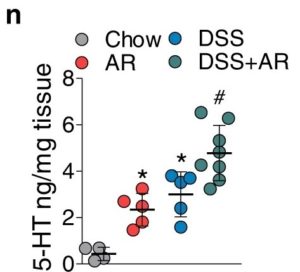 Nature Communications, December 2022,
Nature Communications, December 2022,
13 : 7617
FD&C Red #40 is also commonly called “Allura Red” as it is referred to in this paper. It is abbreviated as “AR” in this study and in the picture at right.
As you can see from the picture, something happens when the mice eating chow containing AR are given dextran sulfate sodium (DSS) which is used in experiments to induce colitis (inflammatory disease in the colon) of mice. In other words, they get a whole lot more sick.
The researchers performed numerous complicated examinations to reveal the interactions of Red 40 with other causes of bowel disease.
RESULTS:
- AR (Red 40) increased the severity of colitis in experimental models of inflammatory bowel disease (IBD).
- ALL the colors tested created bowel problems, but AR did the most damage at the lowest levels.
- The mice developed colitis when they were given chronic exposure to the dye. However, intermittent exposure to AR for 12 weeks did not influence susceptibility to colitis.
- Exposure to AR during early life primes mice to enhanced susceptibility to colitis.
- AR impairs the intestinal epithelial barrier function and induces low-grade colonic inflammation even without DSS (which was given to induce inflammation)
- Gut serotonin (5-HT) plays an important role in enhancing colitis severity by AR. AR promotes 5-HT production by increasing reactive oxygen (ROS). ROS is a known driver of bowel inflammation.
- Transplanting the gut microbiota exposed to AR worsens colitis severity in the recipient germ-free mice.
CONCLUSIONS:
- Continual consumption of AR increases gut 5-HT levels which leads to inflammation.
- This study suggests a potential link between AR and colitis and warrants further exploration between food dyes and IBD at experimental, epidemiological and clinical levels.
QUOTE:
- The senior author, Waliul Khan, was quoted by Sci-Tech Daily, as follows:
“This study demonstrates significant harmful effects of Allura Red on gut health and identifies gut serotonin as a critical factor mediating these effects.
“What we have found is striking and alarming, as this common synthetic food dye is a possible dietary trigger for IBDs. This research is a significant advance in alerting the public on the potential harms of food dyes that we consume daily.”





















We thank the author for corrections offered.
Oh, wow, it increases serotonin!?! Do you think the serotonin might also make people want to have more Red 40, if it affects more than just the gut?
Thanks, Daniela. From the study, it appears that the gut serotonin actually makes them sicker …. in spite of being one of the “feel good” chemicals we make, the serotonin involved in gut health appears to have a different role. How awful to think that it can make us sick and make us want MORE of it at the same time. Here is some more information on what serotonin does in the gut …. maybe it will help. https://transmedcomms.biomedcentral.com/articles/10.1186/s41231-020-00081-y